|
|
| (1) Posted by Zalmen Kornin [Sunday, Jan 28, 2007 15:05] |
Theme Vladimirov - almost 30 years
Before knowing of on-line publications, my only source for this subject was a spanish book by Coello Alonso, "Temas Modernos", that presented almost all the existing samples until around 1995, but whithout the deep insights that can be seen in the on-line article "20 Years of theme Vladimirov" by Milan Velimirovic. So I wish to thank Mr. Velimirovic for this very enlightning material. As I still have the Internet as my main source of information, my question is this - what happened in the third decade of existence of the featured theme, besides of the couple of masterpieces that head the following award? http://www.matplus.org.yu/TY98D2.HTM Thanks in advance for the news
|
|
| (2) Posted by Frank Richter [Sunday, Jan 28, 2007 16:21] |
Here you'll find a very nice example:
http://www.goja.sk/p21a-11.htm
(1st prize by Dragan Stojni�?).
|
|
| (3) Posted by Zalmen Kornin [Sunday, Jan 28, 2007 16:30] |
Yes, I'm seeing - :) thanks!
|
|
| (4) Posted by David Knezevic [Monday, Jan 29, 2007 02:46] |
Dear Zalmen,
I am glad that you found the article usable. I thought that you would be interested to see some more examples, so I uploaded the supplement (published in Mat Plus, Winter 1997) to:
http://www.matplus.org.yu/VLADI2.HTM
As far as last ten years are concerned, I don't think I have enough information to make a comprehensive review. However, if anybody else can do it, I would gladly publish it.
|
|
| (5) Posted by Zalmen Kornin [Wednesday, Jan 31, 2007 10:46] |
Thanks again, Milan Velimirovic, and also for having composed some of the anthologic Vladimirovs! The first article contains still the essential, but the supplement increase the number of Real Vladimirovs appeared still in the past century whith some original ideas, may I mention just T. Maeder's changed battery trick for Real-V., that in fact is more impressive that the tripling of a Pseudo-form...
In the 2004 example showed by Frank Richter the black moves are takes of a Rook in virtual play, and playing to empty 'f5' in the post key play: Could this feature be in some way a *notewhorthy detail*?!
|
|
| (6) Posted by Zalmen Kornin [Wednesday, Jan 31, 2007 11:42] |
Voilà :) D. Stojnic
"Wola Gulowska" 2004
1-st Prize
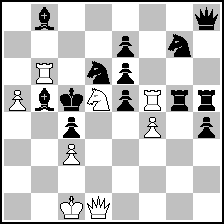 (= 8+13 ) (= 8+13 )
#2 | 1.Sc7 ? A (2.Qd4#)
1... Sgxf5 y 2.Sxe6#
1... Rxf5,f1 2.Qd1#
1... exf5 2.Qd5#
1... Sdxf5 ! x
1.Sf6? B (2.Qd4#)
1... Sdxf5 x 2.Se4#
1... Rxf5,f1 2.Qg1#
1... exf5 2.Qd5
1... Sgxf5! y
1.Rxe5 ! (2.Qd4#)
1... Sdf5 x 2.Sc7# A
1... Sgf5 y 2.Sf6# B
1... Rg1 2.Qxg1#
Ideal Vladimirov |
|
|
| (7) Posted by David Knezevic [Wednesday, Jan 31, 2007 12:32] |
Yes, that's excellent and original mechanism. Rook captures bothered me a bit and tried to find out if they could have been avoided. I constructed the position where it was done at cost of double threat in tries and symmetric play:
Dragan Stojnić
version MV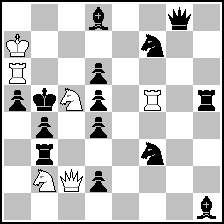 (= 6+14 ) (= 6+14 )
#2 |
1.Se4? ~ 2.Qc4/Qc6#
1... S7e5 2.Sd6:#
1... S3e5!
1.Se6? ~ 2.Qc4/Qc6#
1... S3e5 2.Sd4#
1... S7e5!
1.Rd5:! ~ 2.Qc4#
1... S3e5 2.Se4#
1... S7e5 2.Se6#
1... Rb2:/Rc3/Bb6+ 2.Qd3/Qa4/Rb6:# |
I think that Dragan himself made another version, but I don't have it at hand.
|
|
| (8) Posted by Zalmen Kornin [Thursday, Feb 1, 2007 01:30] |
Better reading "changed battery trick for a combination with a form of Vladimirov, that in fact is more impressive than the tripling of a Pseudo-form..."
The Real-V's in the supplement are, of course, 26-31, while 25 is a - new term - VIRTUAL V. and 43 is a combination of Virtual-(Pseudo)-Vladimirov+Salazar+(Real) Bannyi: well, I like the blend :)...
|
|
| (9) Posted by David Knezevic [Thursday, Feb 1, 2007 02:29] |
Zalmen: "... and 43 is a combination of Virtual-(Pseudo)-Vladimirov+Salazar+(Real) Bannyi ..."
And of course reciprocal change after 1... hg4/Rxf4 in phases 1.Rxc6? and 1.Qb1!... but check out what this batteries-matrix offers (although not a pseudo-Vladimirov):
Paz Einat
3.pr Israel Ring T 1975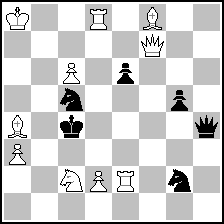 (= 10+6 ) (= 10+6 )
#2 vvvv | 1.Re3? ~ 2.Rc3#
1... Sa4: 2.Qf1# A
1... Sd7 2.Qe6:# B
1... Qh8!
1.Re5? ~ 2.Rc5:#
1... Sa4: 2.Qe6:# B
1... Sd7 2.Qf1# A
1... Qf2!
1.Qf3? ~ 2.Qc3#
1... Sa4: 2.Qd3#
1... Sd7 2.Qb3#
1... Qh8! | | 1.Qf1? ~ 2.Re4#
1... Sa4: 2.Re3# C
1... Sd7 2.Re5# D
1... Sd3!
1.Re6:! ~ 2.Re4#
1... Sa4: 2.Re5# D
1... Sd7 2.Re3# C |
Zagoruiko 5x2 with double reciprocal change!!
Mates C and D with different departure squares = pseudo-reciprocal :)
Great achievement by our twomovers editor. In such kind of task a dual after 1... Sxe6 must be forgiven!
|
|
| (10) Posted by Zalmen Kornin [Thursday, Feb 1, 2007 14:34] |
Yes, quite impressive - and also showed in opus citatus, page 357, number 900 (I'm apologize to Paz Einat for not leaf through all the book before my post in the present item - my only excuse is that the section is 'combinations with Ruchlis or Zagoruiko') - Señor Coello Alonso even refers to some 'efectos Vladimirov', what would make this absolute masterpiece (also) a precursor... (also to be seen in FIDE Album (1974-1976) 1980,
The Art of Israeli Chess Composition 1983,
Chess Wizardry: The New ABC of Chess Problems 1996 etc)
|
|
| (11) Posted by Hauke Reddmann [Thursday, Feb 1, 2007 17:11] |
BTW (I'm not happy until I snipped one pawn off :-) -
what's the point of the Bf8 except needing another
superfluous Pa3 and Ng2? On first glance a wBb4
instead suffices (I didn't do a closer check), and
even the Pd2 can be put back into the box.
Hauke
|
|
| (12) Posted by Miodrag Mladenović [Friday, Feb 2, 2007 07:06]; edited by Miodrag Mladenović [07-02-02] |
Hauke,
Actually it's very important that wPd2 and wBf8 are there. They are preventing duals. Without wPd2 after 1.Qf1? Sd7 there is a dual 2.Rd2#. If wBf8 is on a3 then there is dual after 1.Rxe6 Sd7 2.Rd6#. You want be able to take off neither white pown.
Misha.
|
|
| (13) Posted by Paz Einat [Friday, Feb 2, 2007 12:18] |
Thank you all for the compliments on this problem. You can imagine the thrill of an 18 year old composer being able to achieve this. I left the position on the board for quite a while… I was not aware of the Vladimirov theme at the time but the re-appearance of keys as mates was a feature that appeared in several of my problems from that period.
Regarding WBf8 and WPd2. In the solution one must avoid the dual 1…Sd7 2.Rd6#, that's the job of WBf8, and in the matching try 1.Qf1? the dual 1…Sd7 2.Rd2# is avoided using WPd2. The rest, WPa3 and BSg2 just follow.
|
|
| (14) Posted by Hauke Reddmann [Friday, Feb 2, 2007 12:41] |
Ah, I see. Stupid me :-) (And stupid solving program that doesn't delve
into all the variants...)
Hauke
|
|
| (15) Posted by Frank Richter [Friday, Feb 2, 2007 13:15] |
Because I don't like duals such as 1.Rxe6 Sxe6 2.Qxe6 and Qf1# (a thematic move), I offer the following version:
 (= 10+8 ) (= 10+8 )
1.Qf3?/Re3? Rh3!
Of course the minor duals in the tries 1.Qf3? and 1.Re5? remain, but they are not important.
In any case a really impressive work.
|
|
| (16) Posted by Paz Einat [Friday, Feb 2, 2007 16:51] |
Maybe with a BPb2 instead of BRh2. However, the harmonious refutations by the BQ was a feature I decided not to give up and the cost of the dual was something I accepted.
|
|
| (17) Posted by David Knezevic [Friday, Feb 2, 2007 17:30]; edited by David Knezevic [07-02-02] |
What about these positions:
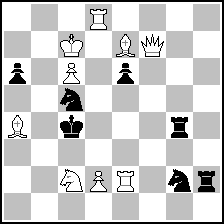 (= 9+7 ) (= 9+7 )
#2 |  (= 10+7 ) (= 10+7 )
#2 | 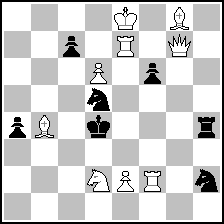 (= 9+7 ) (= 9+7 )
#2 |
The last has 1... Sf3! refutation three times, but also a nice mate 1.Qg1? Se3 2.Qa1# - it would be wonderful if this could be the solution... just how to defeat 1.Rxf6?, to pin that rook somehow?
|
|
No more posts |
MatPlus.Net  Forum Forum  General General  Theme Vladimirov - almost 30 years Theme Vladimirov - almost 30 years |
 ISC 2024
ISC 2024 Forum
Forum  General
General  Theme Vladimirov - almost 30 years
Theme Vladimirov - almost 30 years 


